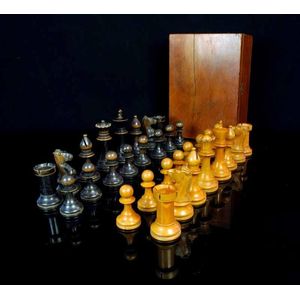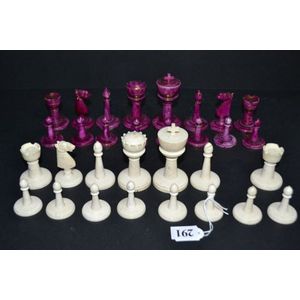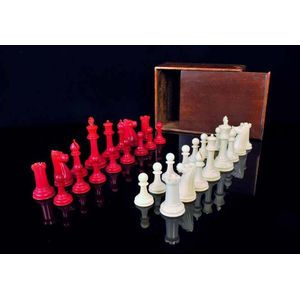Antique Ivory Chess Set - Staunton Design (1900)
You must be a subscriber, and be logged in to view price and dealer details.
Subscribe Now to view actual auction price for this item
When you subscribe, you have the option of setting the currency in which to display prices to $Au, $US, $NZ or Stg.
- Ivory - Ivory is a hard white material that comes from the tusks of elephants, mammoth, walrus and boar, or from the teeth of hippopotamus and whales. The ivory from the African elephant is the most prized source of ivory. Although the mammoth is extinct, tusks are still being unearthed in Russia and offered for sale.
Ivory has been used since the earliest times as a material for sculpture of small items, both in Europe and the east, principally China and Japan.
In Asia ivory has been carved for netsuke, seals, okimono, card cases, fan supports, animals and other figures and even as carved tusks.
In the last 200 years in Europe ivory has been used to carve figures, for elaborate tankards, snuff boxes, cane handles, embroidery and sewing accessories, in jewellery and as inlay on furniture. Its more practical uses include being used for billiard balls, buttons, and a veneers on the top of piano keys.
The use and trade of elephant ivory have become controversial because they have contributed to Due to the decline in elephant populations because of the trade in ivory, the Asian elephant was placed on Appendix One of the Convention on International Trade in Endangered Species (CITES), in 1975, and in January 1990, the African elephant was similarly listed. Under Appendix One, international trade in Asian or African elephant ivory between member countries is forbidden. Unlike trade in elephant tusks, trade in mammoth tusks is legal.
Since the invention of plastics, there have been many attempts to create an artificial ivory - Staunton Chess Set - How should the king, queen, rooks and other pieces be depicted? Why is the king always the tallest piece and have a cross on his head. And why is the knight depicted as a horse head?
Until the adaption of a standard design, the designs of the pieces in every set varied. The Staunton chess set set a standard design for each piece used in the game of chess, and was the style adopted for use in chess competitions.
The Staunton designs were developed in 1849 and sold by sports and games manufacturers Jaques & Son of London, and were either designed by the proprietor of the firm, John Jaques or his his brother in law, Nathaniel Cook.
The design was named after Howard Staunton, an English chess player who was regarded as the leading player in the 1840s to 1850s.
The style has been popular for more than 160 years, and is still the standard today in tournament chess games and competitions.
This item has been included into following indexes:
- games and puzzles, chess
Visually similar items

A Staunton design boxwood weighted chess set, c.1900, likely English, dark pieces ebonized finish, King height 9.5 cm

A Victorian turned ivory chess set with rosewood playing board, c.1850, in the Barleycorn pattern. Turned and coloured ivory. The playing board is made up from rosewood and boxwood squares and measures 40.5 x 40.5 cm. King height 8.8 cm

Set of vintage ivory chess set pieces (missing one knight)

18 various Geo/Victorian hallmarked sterling silver tea spoons. Birmingham 1929 (1); London 1881 (1); London 1836 (6); Exeter 1840s (3), marks rubbed; Exeter 1828 (5); and Dublin 1866 (2). All monogrammed. Some wear. Wt. 319g (total)
